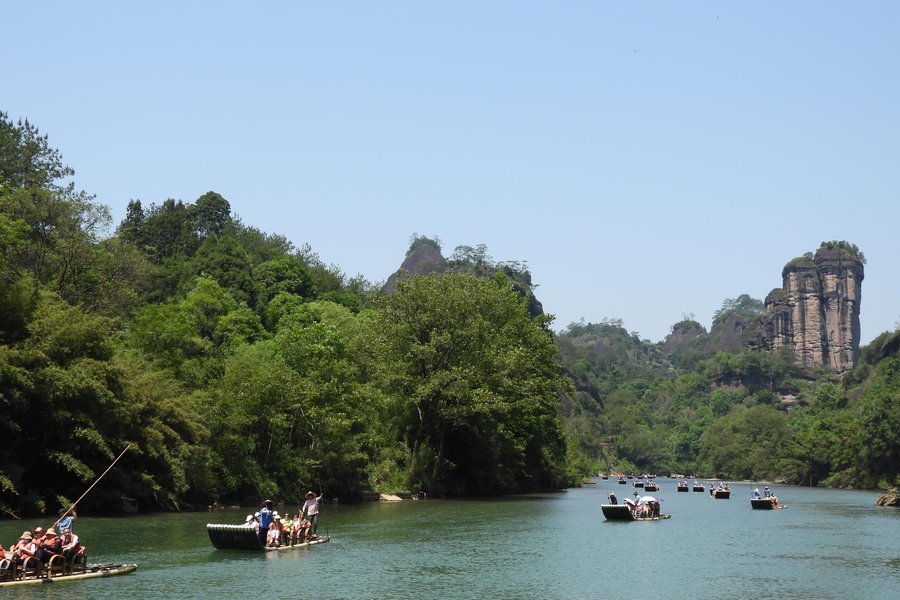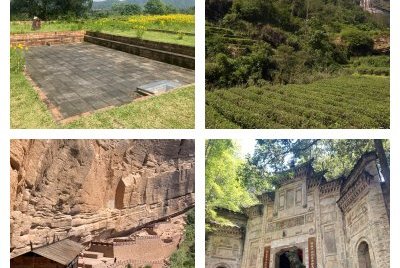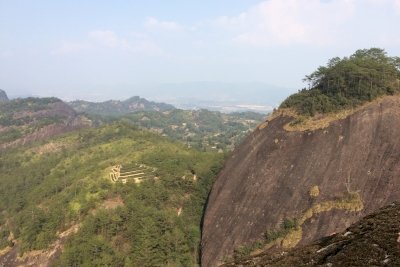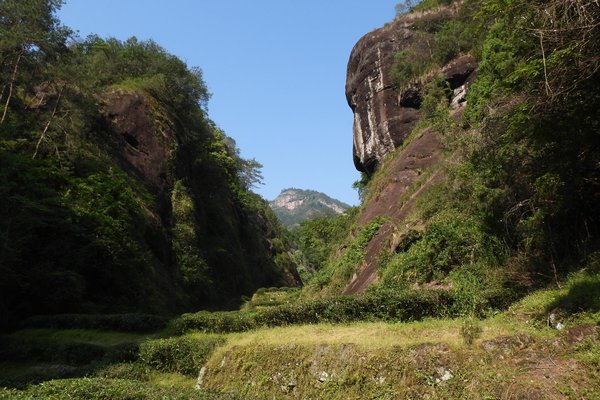China
Mount Wuyi
Mount Wuyi is a scenic landscape of forests and deep gorges, which became the cradle of Neo-Confucianism.
The area contains several archaeological sites, including a Han City established in the 1st century BCE, and a number of temples and study centres associated with the birth of Neo-Confucianism in the 11th century CE. Its natural values include the beauty of the gorges of the Nine-Bend River, the monoliths of local red sandstone, its subtropical forests, and its reptile, amphibian and insect species diversity.
Community Perspective: Hiking and rafting are the main things to do here. Els explored the Han City component and recommends the Da Hong Pao Tea Trail.
Site Info
Official Information
- Full Name
- Mount Wuyi (ID: 911)
- Country
- China
- Status
-
Inscribed 1999
Site history
History of Mount Wuyi
- 2017: Boundary change
- Extension of Mount Wuyi with 7,069 ha to its north slopes, located in Jiangxi Province (as a Minor Boundary Change)
- 1999: Inscribed
- Inscribed
- Type
- Mixed
- Criteria
- iii
- vi
- vii
- x
Links
- UNESCO
- whc.unesco.org
- Official
-
- travelchinaguide.com — Travel China Guide Wuyi Shan
- Related
-
- en.wikipedia.org — The Wuyi Mountains on Wikipedia
All Links
UNESCO.org
- whc.unesco.org — whc.unesco.org/
Official Website
- travelchinaguide.com — Travel China Guide Wuyi Shan
Related Resources
- en.wikipedia.org — The Wuyi Mountains on Wikipedia
News Article
- June 30, 2015 cctv-america.com — New high speed train offers amazing views of Mount Huangshan, Mount Wuyi, and Mount Sanqingshan.
- June 2, 2009 news.xinhuanet.com — Tourists banned from Mount Wuyi to protect ancient forest
Community Information
- Community Category
- Natural landscape: Forest
- Religious structure: Indigenous
Travel Information
Fujian Hotspot
Recent Connections
-
Perfect Inscriptions
1999 -
Mixed and Serial
The 2nd component is purely cultural, t… -
Refugium
"Because of the wide variety of geologi…
Connections of Mount Wuyi
- Trivia
-
-
On Passports
Chinese passport: Fujian -> Wuyishan
-
- History
-
-
Located in a Former Capital
During the Western Han Dynasty, the ancient city of Chengcun was the capital of the Minyue kingdom
-
- Ecology
-
-
Rainforests
"It is the largest, most representative example of a largely intact forest encompassing the diversity of the Chinese Subtropical Forest and the South Chinese Rainforest, with high plant diversity." (OUV crit X) -
Tiger habitat
IUCN said in its evaluation that it contains the "near extinct S China Tiger". Some estimates put the entire wild population at less than 20 individuals but elsewhere it is stated that it hasn't been seen in the wild anywhere for 20 years -
Refugium
"Because of the wide variety of geological and geomorphological niches, microclimates, and the lack of any significant impact of the Pleistocene glaciations, Mount Wuyi has become a refuge for ancient and relic plants which are very rare elsewhere in China" (AB ev IUCN) -
Salamanders
Chinese giant salamander, the largest salamander in the world -
Living Fossils
Gingko BilobaSee en.wikipedia.org
-
Critically endangered fauna species
Chinese giant salamander - declining fast, "Commercial over-exploitation for human consumption is the main threat to the Chinese giant salamander. They are considered to be both a luxury food item and an important source of traditional medicines in China."
-
- World Heritage Process
-
-
Perfect Inscriptions
1999 -
Mixed and Serial
The 2nd component is purely cultural, the 1st mixed. -
Minor modifications after inscription
2017: to add "a section of Mount Wuyi lying in Jiangxi Province to the large component part of the property", and reconfigure the buffer zone -
Extensions on Tentative List
Jinggangshan--North Wuyishan (Extension of Mount Wuyi)
-
- Religion and Belief
-
-
Taoism
"few of the Taoist temples and monasteries, more than 60 of which have been located, survive to any degree of completeness. Among the exceptions are the Taoyuan Temple, the Wannian Palace, the Sanqing Hall, the Tiancheng Temple, the Baiyun temple, and the Tianxin temple, all of which have survived to varying degrees of authenticity" (AB ev) -
Confucianism
contains study centres associated with the birth of Neo-Confucianism in the 11th century AD -
Sacred Mountains
"With the consolidation of the Chinese Empire by the Han Dynasty (late 3rd century BC to early 3rd century AD) Wuyi was fully incorporated into the state system... It was at this time that Mount Wuyi (Wuyishan) acquired its status as a sacred mountain" (AB ev ICOMOS)
-
- Human Activity
-
-
Tea
AB "Also of interest is the evidence of the tea culture. In the 11th to 16th centuries there was an Imperial tea farm here, producing tea for the Imperial Court. Certain original elements survive, but the remainder of the structures visible today are recent reconstructions. In addition, the remains of ancient tea factories, from the 17th century onwards, also survive, mostly in fragmentary form." Also see re Tianxin Temple
-
- Constructions
-
-
Walled cities
Han city of Chengcun: "a walled city enclosing some 48ha of uneven land. The circuit of walls survives intact" (AB ev) -
Cultural sites connected to Cliffs
"eighteen wooden boat coffins in rock shelters high on the steep cliffs" (AB ev ICOMOS) -
Tombs
"There is also a number of tombs, the oldest dating back to the Shang Dynasty (late 2nd millennium BC)" (AB ev)
-
- WHS on Other Lists
-
-
Centres of Plant Diversity
EA14 Wuyi Mountain - "The largest, most representative example of a largely intact forest encompassing the diversity of the Chinese Subtropical Forest and the South Chinese Rainforest, with high plant diversity. It acts as a refuge for a large number of ancient, relict plant species, many of them endemic to China and rare elsewhere in the country. " -
World Heritage Forest Programme
-
U.S. Ambassadors Fund
Preventive Conservation of the Han Dynasty Collection (2nd Century BC) at the Fujian Minyue Kingdom Capital Museum (2005) -
World Biosphere Reserves
Wuyishan (1987)
-
- Timeline
-
-
Built in the 1st century BC
"It (Mount Wuyi) contains a series of exceptional archaeological sites, including the Han City established in the 1st century BC and a number of temples and study centres associated with the birth of Neo-Confucianism in the 11th century AD. The archaeological site of the Han city of Chengcun was discovered in 1958, this is a walled city. The circuit of walls survives intact; the layout of the town is in accordance with the principle of urban design characteristic of southern China at this period." - Nomination File -
Jurassic
Mount Wuyi's Danxia landform developed mainly between the Jurassic Period and the Tertiary Period in the red horizontal or slightly declining strata
-
- WHS Hotspots
-
-
Fujian Hotspot
Fast Train To Wuyishan North or Nanping (3-4h from Xiamen/1-1.5h from Fuzhou/2-3h from Quanzhou) + Direct bus to Scenic Area (1 h)
-
- Science and Technology
-
-
Confucian Academy (Shuyuan, Seowon, Shijuku)
"there are no fewer than 35 ancient Confucian academies dating from the Northern Song to Qing Dynasties (10th to 19th centuries CE)" (OUV)
-
- WHS Names
-
-
Named after a Mountain
Mt Wuyi
-
News
- cctv-america.com 06/30/2015
- New high speed train offers amazin…
- news.xinhuanet.com 06/02/2009
- Tourists banned from Mount Wuyi to…
Recent Visitors
Visitors of Mount Wuyi
- Alexander Lehmann
- Alex Goh
- Alex Marcean
- Ansitong
- Atila Ege
- Bill Koo
- Bin
- Bundi Cao
- chenboada
- Christravelblog
- Csaba Nováczky
- cwthong
- Dwight Zehuan Xiao
- Els Slots
- Fan Yibo
- henryjiao18
- Iain Jackson
- Jeffrey Chai
- Jonas Kremer
- jxrocky
- Kasper
- Knut
- KoenigMarke
- Lee Kai Loong
- lichia
- Ludvan
- Luke LOU
- MaYumin
- Miloš Tašković
- Ming_9734
- Nihal Ege
- Patrik
- Roman Bruehwiler
- Sergio Arjona
- Shijie ZHU
- Ssong.x
- Stanislaw Warwas
- Taotao Chen
- trekkie900
- voyager
- wantrain.
- Weecheng
- Xander Huang
- Xiong Wei
- Xiquinho Silva
- Yang Chengyu
- Yongcheng Liu
- Zhou Yan
- Zoë Sheng
- Zos M
Community Reviews
Show full reviews
The WHS boundary of Mount Wuyi includes the west most part of Jiangxi province and the northwest part of Fujian province. As a mixed site, Mount Wuyi is famous for both its natural beauty and historic value.
The natural part of Mount Wuyi, of course deserves its inscription as a natural heritage. The whole area is in Danxia landform (regions with cliffs and red stones formed with the force of water), similar to all the locations inscribed in another world natural heritage site "China Danxia". Inside the Mount Wuyi Scenic Area, there are three most famous peaks that are inscribed: Tianyou ("wandering in the heaven") Peak, Yu'nü ("jade lady", used to describe beautiful young female) Peak and Dawang ("the king") Peak. You could easily access all the three peaks by the shuttle bus (70 RMB per person per day), and hike both Tianyou Peak and Dawang Peak. Yu'nü Peak, however, is almost impossible to hike but is the most iconic site inside the national park. It is said that the peak obtained its name because of the similarity of its shape with young female, however I could not identify any resemblance. Besides the mountains, the Jiuqu Stream is also inscribed into the natural part. One could easily take a bamboo raft to raft along the stream (a total time of about 1 hour and 20 minutes). During the raft, you could see all three peaks, as well as the Boat Coffins hanging on the cliffs and the Cliff Rock …
Keep reading 0 comments
The WHS of Mount Wuyi has not been covered well by reviews yet - at least I think they do not do justice to the complexity of this mixed WHS. After reading beforehand about what to see and do in the area I decided to spend more than one day here and explore various parts.
On my arrival day, I moved straight to the second location called “Ruin of Han Dynasty City”. This lies some 15km outside of the Wuyi scenic area. From Nanpingshi railway station (formerly known as Wuyishan East) I took the recently installed tramway and got off at Chengcun, from where it’s a 3km walk to the ruins (it’s signposted and you can use the bike path). It’s a location of interest in the inscription history of this WHS, as ICOMOS in 1999 actually considered it a separate site and thought it would be better to split this cultural archeological site from the more nature-focused main site.
The split didn’t happen though and now the Han City Ruins are part of the Wuyi WHS, and they proudly display the WH logo everywhere. Strangely, access regulations are different between the two locations – while the main site requires quite costly one or multiple-day passes, the entrance here is free. The ruins lie in a sleepy village and at the sites (I went to the museum and the palace ruins) no one else was around except for one person at each reception. The museum is quite a …
Keep reading 0 comments
I visited Wuyi Shan in Feb. 2017 on a weekend I had spare, being in Fujian Province on business at the time and this being one of the reachable UNESCO sites from where I was based.
The two main activities are floating along the river on a raft (accompanied by what I assume was some sort of running commentary, tea and music) as well as rambling across the mountainous terrain which features many tea plantations - some of which were purportedly slated for imperial use due to their specific geographic location and thus I assume climate / sun / shade / soil / overall quality.
There is also a temple and a cave which you will come across, with all the major sights being serviced by regular shuttle-buses. A one-day tour ticket was Y150 at the time.
I'm not sure I'd go out of my way to travel here if I weren't already nearby for other reasons, but it did give me a chance to stretch my legs and get some fresh air away from industrial cities and I did want to share a few photos given that there have yet to be any published.
AW
05 Mar. 2018
Keep reading 0 comments
Mt Wuyi is one of the best places to visit if you want to get away from the busy similar places such as Mount Longhu where you get to see the same rock-graves and formations, a trip down the lake on a raft and it comes with an "Impressions Wuyishan" as you might have seen in Lijiang, West Lake or Haikou. Worth a visit for the evening as there is not much else to do after dark aside from eating. There are not many foreign tourists here but busloads of Chinese tourists which means they amass at the bus stations but won't venture too far into the walking area.
Let's get started with the mountain. There are 2 areas to visit and the main spots are connected with a free shuttle bus if you bought the entrance ticket which is valid for several entrance gates so you don't have to visit all in one day. You are recommended to take one day for the northern part alone as there is a lot to see and gently hike, and then finish off with the raft trip. The next day should go to the southern area. Doing all in one day is possible but a bit tight especially as you need to time the rafting when you buy the ticket. There are not many steps up and down and the term mountain is misleading in this case. There are many rocks around you and once in a while you will have a …
Keep reading 0 comments
